NRS-434VN Developmental Assessment: Pediatric Patient Needs
VerifiedAdded on 2023/01/05
|7
|1299
|73
Report
AI Summary
This report provides a comprehensive overview of the nursing care required for pediatric patients, focusing on the physical assessments of school-aged children. It details the techniques of inspection, palpation, percussion, and auscultation, highlighting modifications based on the child's age and developmental stage. The report also explores the developmental stages of a five-year-old, including physical, motor, cognitive, language, and social development. Furthermore, it applies Erikson's theory of psychosocial development to understand the child's psychological needs and the importance of parental guidance. The report emphasizes the significance of parental involvement in the child's health and well-being, concluding with guidelines for parents to support their child's growth and development. It stresses the importance of understanding the child's perspective and using appropriate communication strategies during assessments and care, ensuring a holistic approach to pediatric patient care.
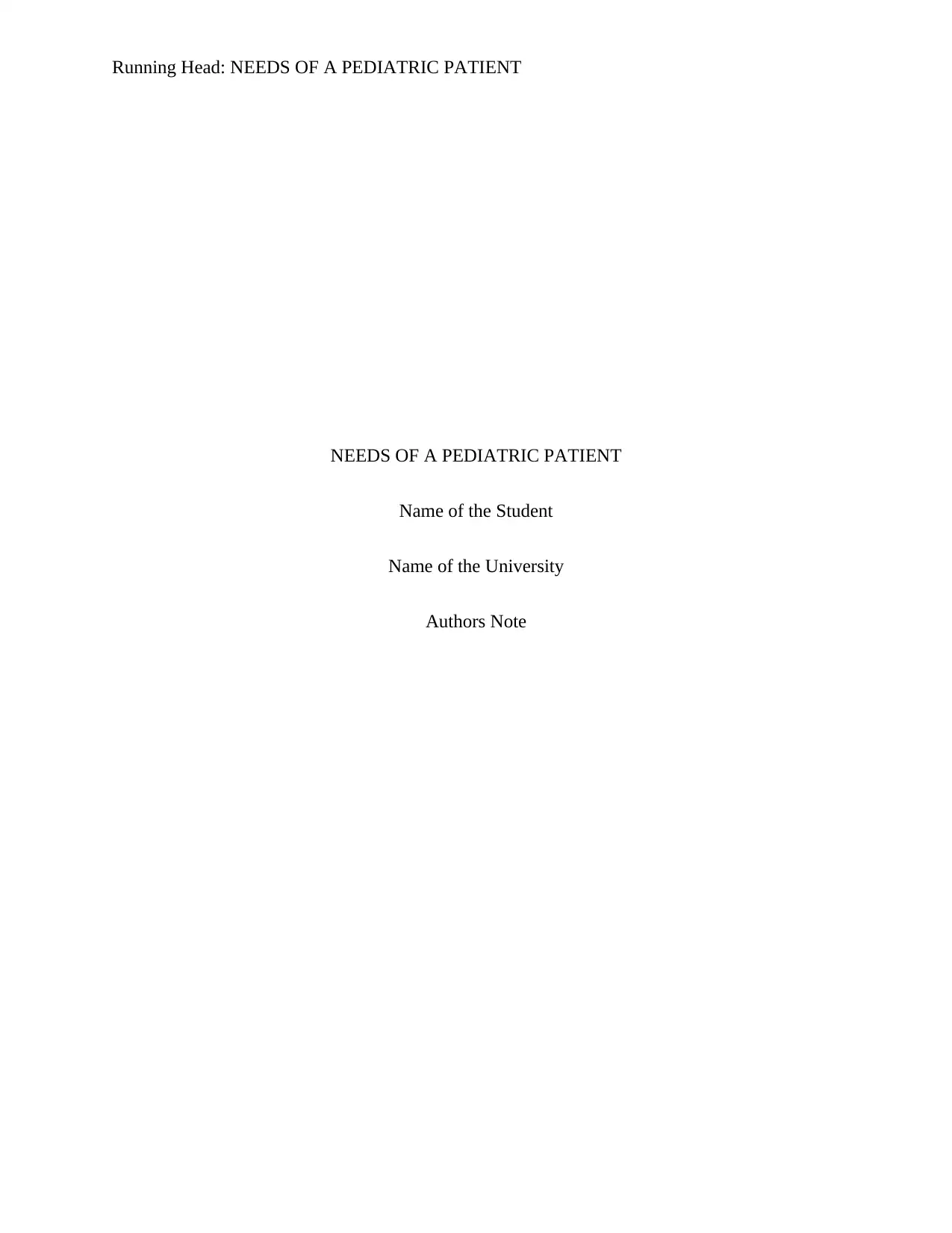
Running Head: NEEDS OF A PEDIATRIC PATIENT
NEEDS OF A PEDIATRIC PATIENT
Name of the Student
Name of the University
Authors Note
NEEDS OF A PEDIATRIC PATIENT
Name of the Student
Name of the University
Authors Note
Paraphrase This Document
Need a fresh take? Get an instant paraphrase of this document with our AI Paraphraser
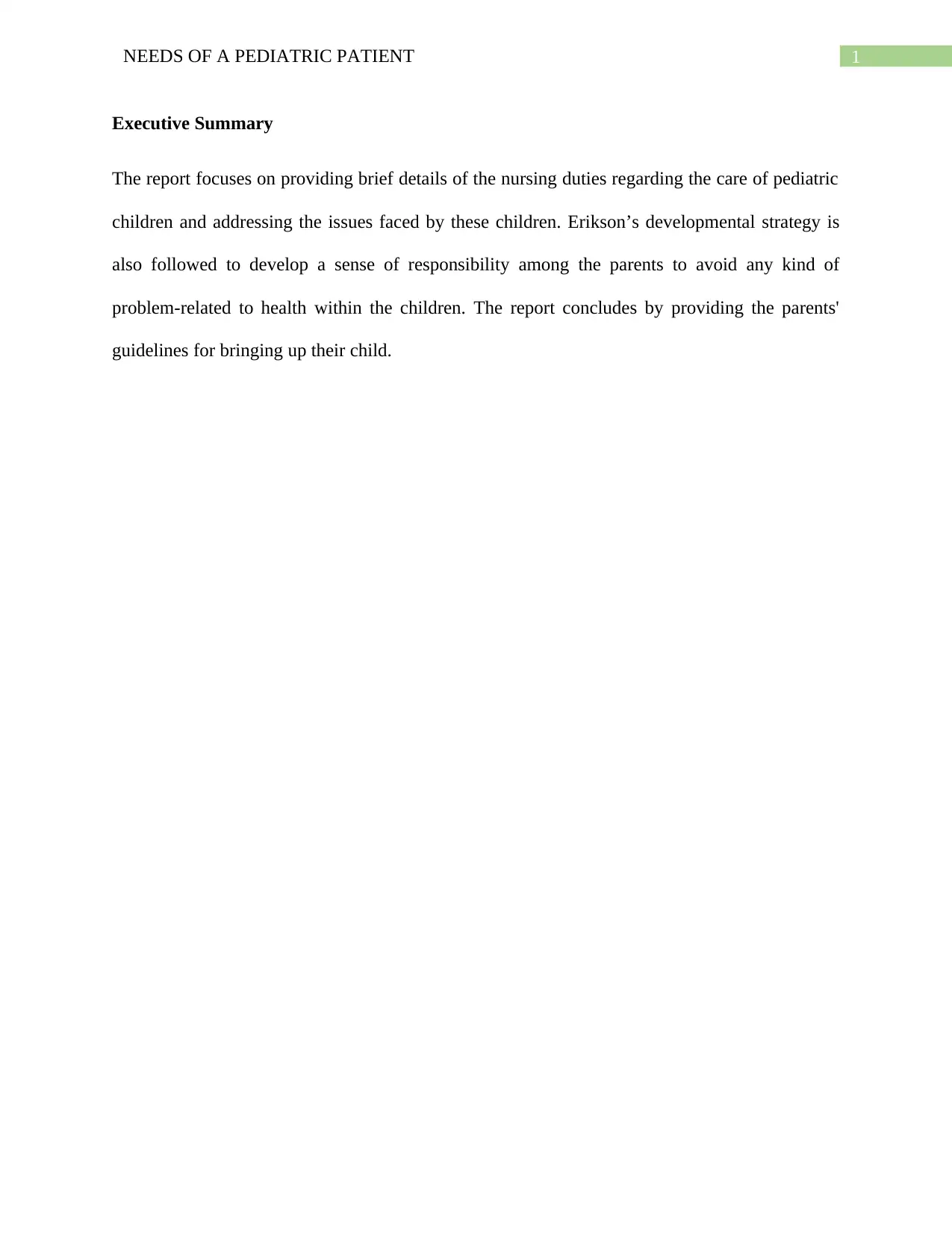
1NEEDS OF A PEDIATRIC PATIENT
Executive Summary
The report focuses on providing brief details of the nursing duties regarding the care of pediatric
children and addressing the issues faced by these children. Erikson’s developmental strategy is
also followed to develop a sense of responsibility among the parents to avoid any kind of
problem-related to health within the children. The report concludes by providing the parents'
guidelines for bringing up their child.
Executive Summary
The report focuses on providing brief details of the nursing duties regarding the care of pediatric
children and addressing the issues faced by these children. Erikson’s developmental strategy is
also followed to develop a sense of responsibility among the parents to avoid any kind of
problem-related to health within the children. The report concludes by providing the parents'
guidelines for bringing up their child.
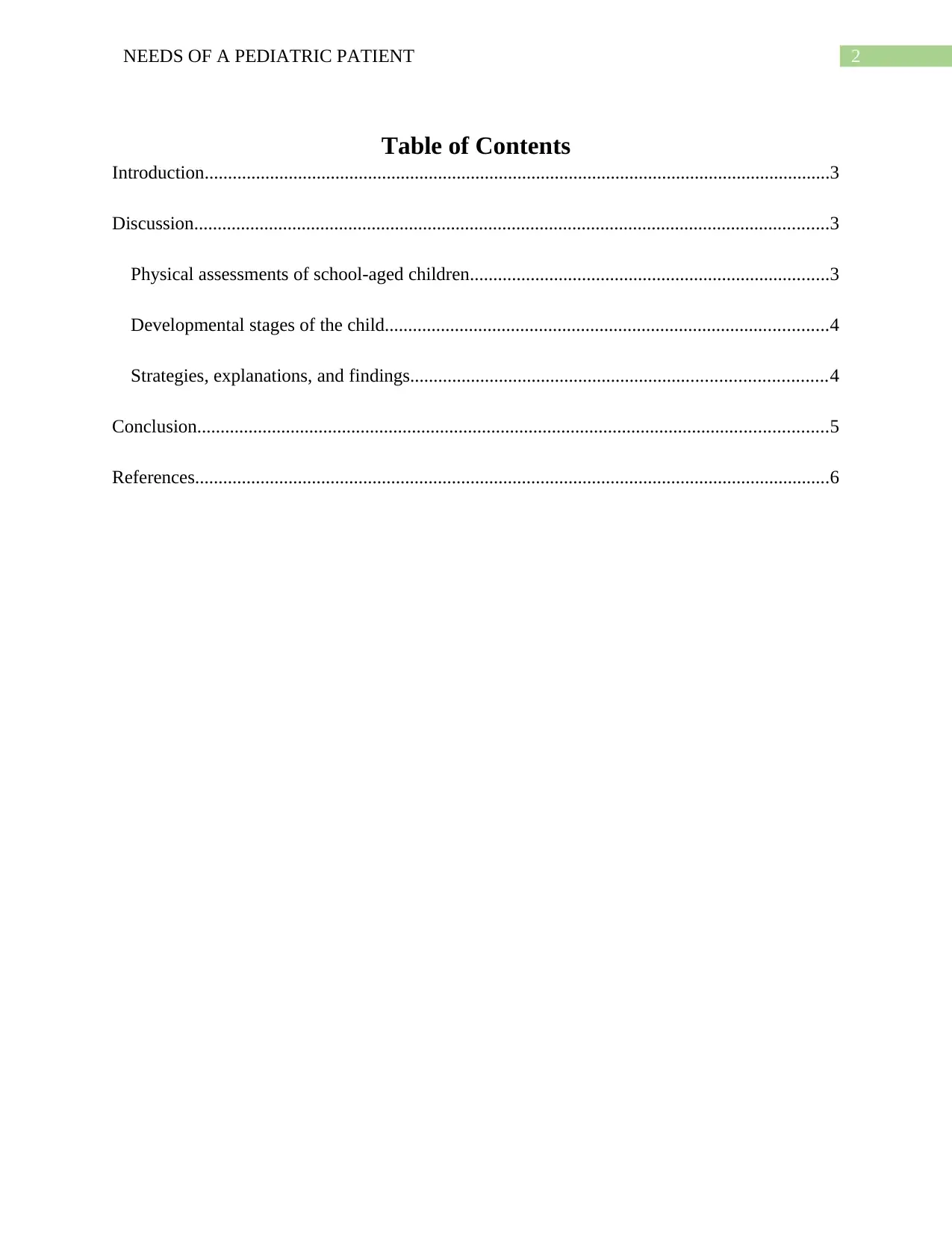
2NEEDS OF A PEDIATRIC PATIENT
Table of Contents
Introduction......................................................................................................................................3
Discussion........................................................................................................................................3
Physical assessments of school-aged children.............................................................................3
Developmental stages of the child...............................................................................................4
Strategies, explanations, and findings.........................................................................................4
Conclusion.......................................................................................................................................5
References........................................................................................................................................6
Table of Contents
Introduction......................................................................................................................................3
Discussion........................................................................................................................................3
Physical assessments of school-aged children.............................................................................3
Developmental stages of the child...............................................................................................4
Strategies, explanations, and findings.........................................................................................4
Conclusion.......................................................................................................................................5
References........................................................................................................................................6
⊘ This is a preview!⊘
Do you want full access?
Subscribe today to unlock all pages.

Trusted by 1+ million students worldwide
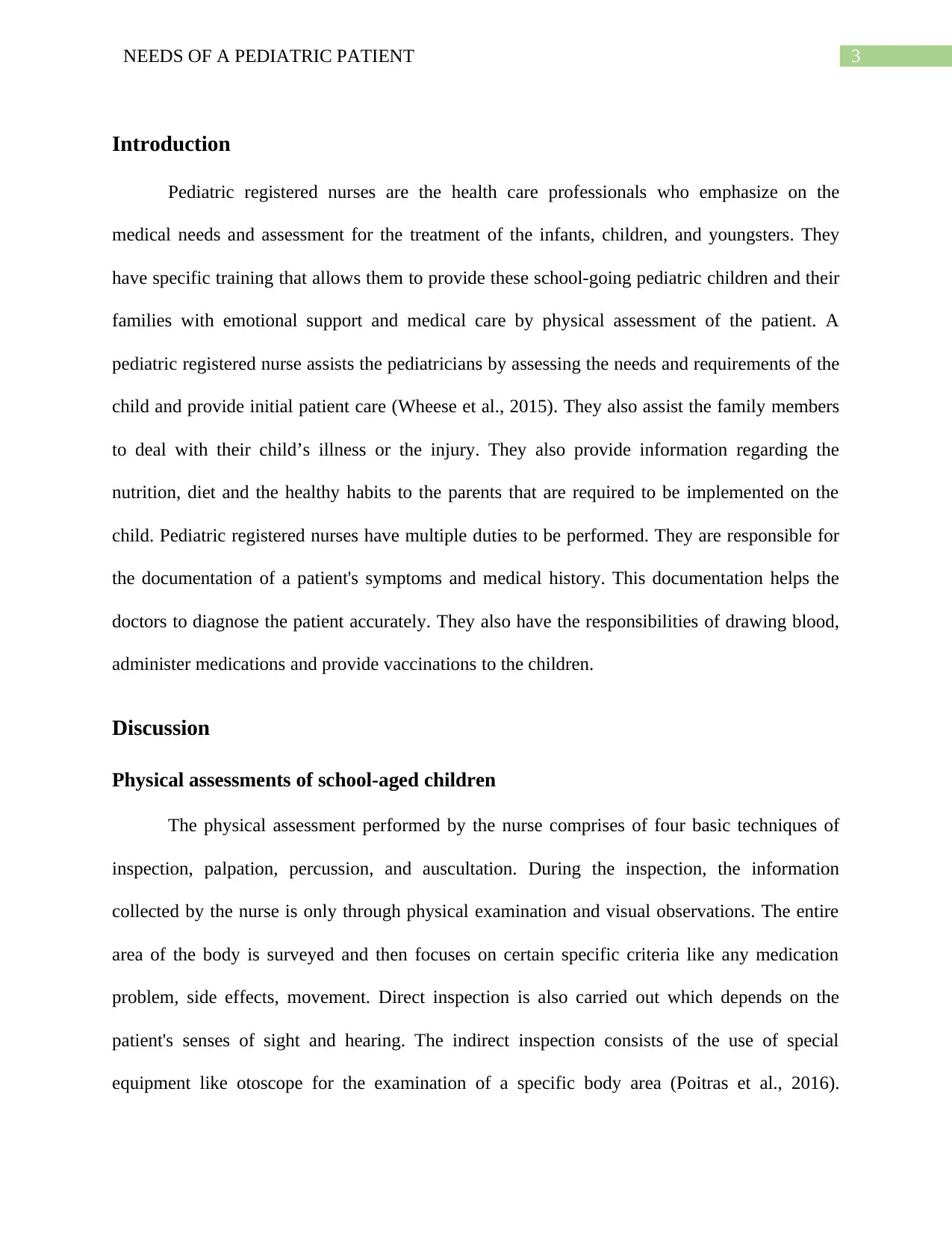
3NEEDS OF A PEDIATRIC PATIENT
Introduction
Pediatric registered nurses are the health care professionals who emphasize on the
medical needs and assessment for the treatment of the infants, children, and youngsters. They
have specific training that allows them to provide these school-going pediatric children and their
families with emotional support and medical care by physical assessment of the patient. A
pediatric registered nurse assists the pediatricians by assessing the needs and requirements of the
child and provide initial patient care (Wheese et al., 2015). They also assist the family members
to deal with their child’s illness or the injury. They also provide information regarding the
nutrition, diet and the healthy habits to the parents that are required to be implemented on the
child. Pediatric registered nurses have multiple duties to be performed. They are responsible for
the documentation of a patient's symptoms and medical history. This documentation helps the
doctors to diagnose the patient accurately. They also have the responsibilities of drawing blood,
administer medications and provide vaccinations to the children.
Discussion
Physical assessments of school-aged children
The physical assessment performed by the nurse comprises of four basic techniques of
inspection, palpation, percussion, and auscultation. During the inspection, the information
collected by the nurse is only through physical examination and visual observations. The entire
area of the body is surveyed and then focuses on certain specific criteria like any medication
problem, side effects, movement. Direct inspection is also carried out which depends on the
patient's senses of sight and hearing. The indirect inspection consists of the use of special
equipment like otoscope for the examination of a specific body area (Poitras et al., 2016).
Introduction
Pediatric registered nurses are the health care professionals who emphasize on the
medical needs and assessment for the treatment of the infants, children, and youngsters. They
have specific training that allows them to provide these school-going pediatric children and their
families with emotional support and medical care by physical assessment of the patient. A
pediatric registered nurse assists the pediatricians by assessing the needs and requirements of the
child and provide initial patient care (Wheese et al., 2015). They also assist the family members
to deal with their child’s illness or the injury. They also provide information regarding the
nutrition, diet and the healthy habits to the parents that are required to be implemented on the
child. Pediatric registered nurses have multiple duties to be performed. They are responsible for
the documentation of a patient's symptoms and medical history. This documentation helps the
doctors to diagnose the patient accurately. They also have the responsibilities of drawing blood,
administer medications and provide vaccinations to the children.
Discussion
Physical assessments of school-aged children
The physical assessment performed by the nurse comprises of four basic techniques of
inspection, palpation, percussion, and auscultation. During the inspection, the information
collected by the nurse is only through physical examination and visual observations. The entire
area of the body is surveyed and then focuses on certain specific criteria like any medication
problem, side effects, movement. Direct inspection is also carried out which depends on the
patient's senses of sight and hearing. The indirect inspection consists of the use of special
equipment like otoscope for the examination of a specific body area (Poitras et al., 2016).
Paraphrase This Document
Need a fresh take? Get an instant paraphrase of this document with our AI Paraphraser
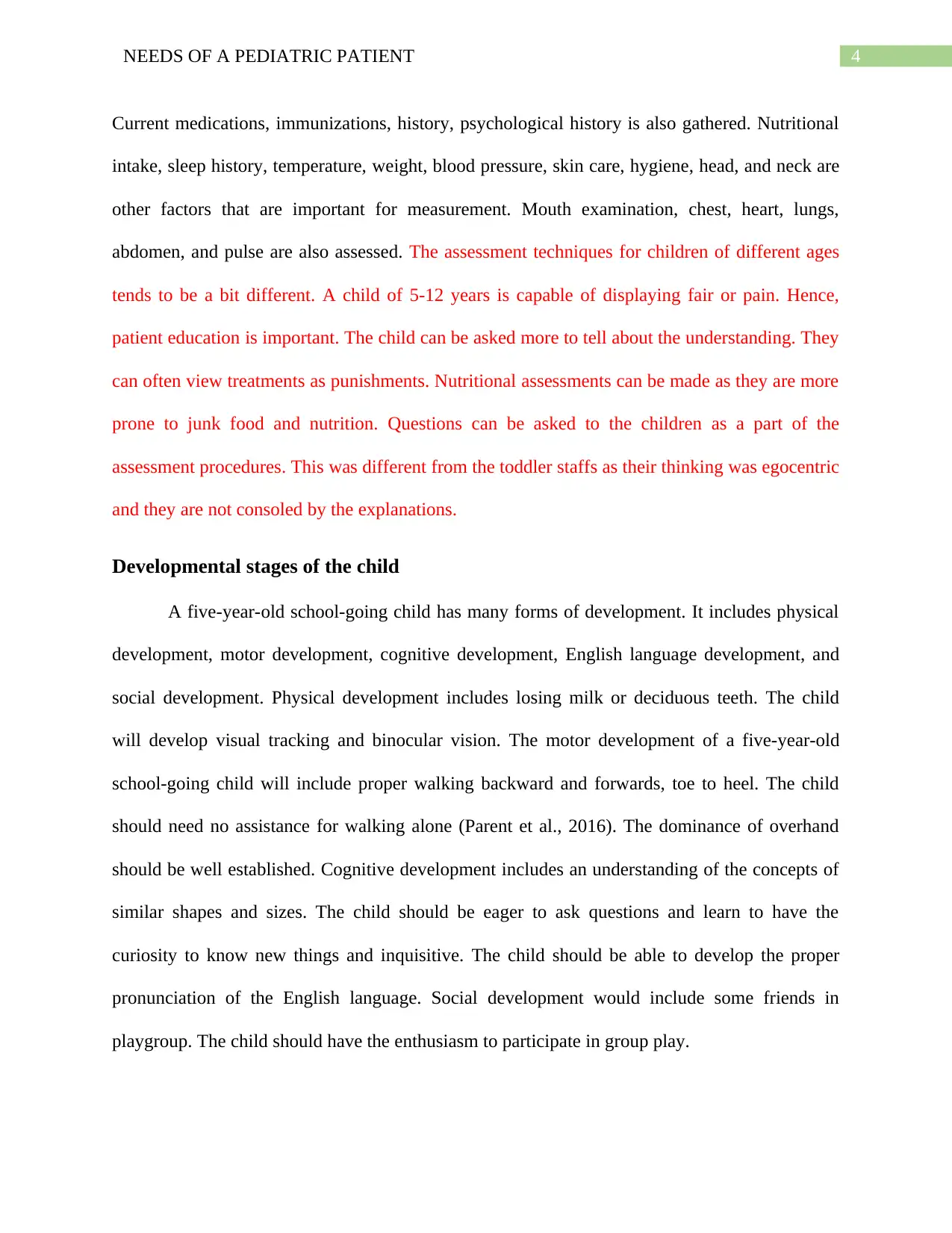
4NEEDS OF A PEDIATRIC PATIENT
Current medications, immunizations, history, psychological history is also gathered. Nutritional
intake, sleep history, temperature, weight, blood pressure, skin care, hygiene, head, and neck are
other factors that are important for measurement. Mouth examination, chest, heart, lungs,
abdomen, and pulse are also assessed. The assessment techniques for children of different ages
tends to be a bit different. A child of 5-12 years is capable of displaying fair or pain. Hence,
patient education is important. The child can be asked more to tell about the understanding. They
can often view treatments as punishments. Nutritional assessments can be made as they are more
prone to junk food and nutrition. Questions can be asked to the children as a part of the
assessment procedures. This was different from the toddler staffs as their thinking was egocentric
and they are not consoled by the explanations.
Developmental stages of the child
A five-year-old school-going child has many forms of development. It includes physical
development, motor development, cognitive development, English language development, and
social development. Physical development includes losing milk or deciduous teeth. The child
will develop visual tracking and binocular vision. The motor development of a five-year-old
school-going child will include proper walking backward and forwards, toe to heel. The child
should need no assistance for walking alone (Parent et al., 2016). The dominance of overhand
should be well established. Cognitive development includes an understanding of the concepts of
similar shapes and sizes. The child should be eager to ask questions and learn to have the
curiosity to know new things and inquisitive. The child should be able to develop the proper
pronunciation of the English language. Social development would include some friends in
playgroup. The child should have the enthusiasm to participate in group play.
Current medications, immunizations, history, psychological history is also gathered. Nutritional
intake, sleep history, temperature, weight, blood pressure, skin care, hygiene, head, and neck are
other factors that are important for measurement. Mouth examination, chest, heart, lungs,
abdomen, and pulse are also assessed. The assessment techniques for children of different ages
tends to be a bit different. A child of 5-12 years is capable of displaying fair or pain. Hence,
patient education is important. The child can be asked more to tell about the understanding. They
can often view treatments as punishments. Nutritional assessments can be made as they are more
prone to junk food and nutrition. Questions can be asked to the children as a part of the
assessment procedures. This was different from the toddler staffs as their thinking was egocentric
and they are not consoled by the explanations.
Developmental stages of the child
A five-year-old school-going child has many forms of development. It includes physical
development, motor development, cognitive development, English language development, and
social development. Physical development includes losing milk or deciduous teeth. The child
will develop visual tracking and binocular vision. The motor development of a five-year-old
school-going child will include proper walking backward and forwards, toe to heel. The child
should need no assistance for walking alone (Parent et al., 2016). The dominance of overhand
should be well established. Cognitive development includes an understanding of the concepts of
similar shapes and sizes. The child should be eager to ask questions and learn to have the
curiosity to know new things and inquisitive. The child should be able to develop the proper
pronunciation of the English language. Social development would include some friends in
playgroup. The child should have the enthusiasm to participate in group play.
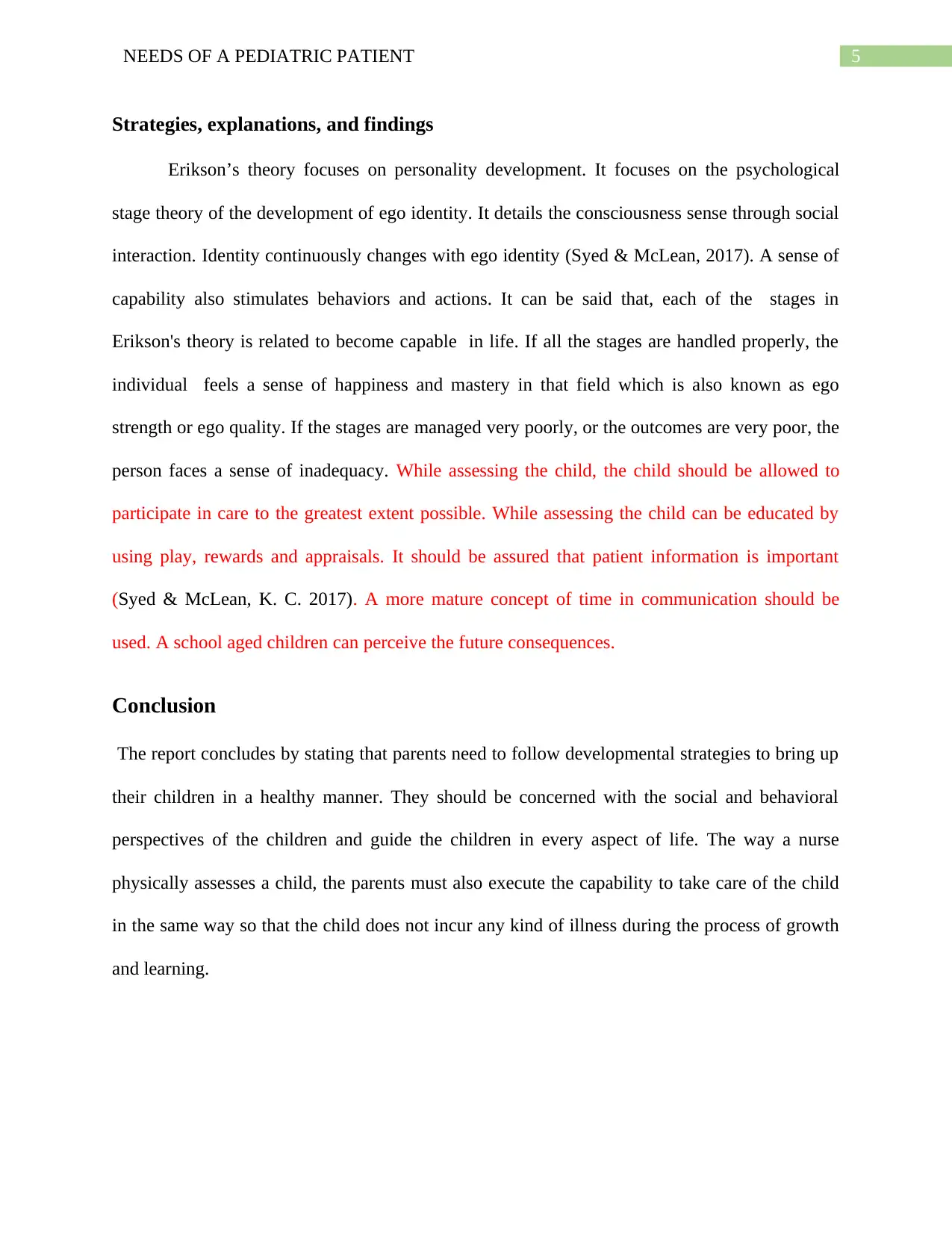
5NEEDS OF A PEDIATRIC PATIENT
Strategies, explanations, and findings
Erikson’s theory focuses on personality development. It focuses on the psychological
stage theory of the development of ego identity. It details the consciousness sense through social
interaction. Identity continuously changes with ego identity (Syed & McLean, 2017). A sense of
capability also stimulates behaviors and actions. It can be said that, each of the stages in
Erikson's theory is related to become capable in life. If all the stages are handled properly, the
individual feels a sense of happiness and mastery in that field which is also known as ego
strength or ego quality. If the stages are managed very poorly, or the outcomes are very poor, the
person faces a sense of inadequacy. While assessing the child, the child should be allowed to
participate in care to the greatest extent possible. While assessing the child can be educated by
using play, rewards and appraisals. It should be assured that patient information is important
(Syed & McLean, K. C. 2017). A more mature concept of time in communication should be
used. A school aged children can perceive the future consequences.
Conclusion
The report concludes by stating that parents need to follow developmental strategies to bring up
their children in a healthy manner. They should be concerned with the social and behavioral
perspectives of the children and guide the children in every aspect of life. The way a nurse
physically assesses a child, the parents must also execute the capability to take care of the child
in the same way so that the child does not incur any kind of illness during the process of growth
and learning.
Strategies, explanations, and findings
Erikson’s theory focuses on personality development. It focuses on the psychological
stage theory of the development of ego identity. It details the consciousness sense through social
interaction. Identity continuously changes with ego identity (Syed & McLean, 2017). A sense of
capability also stimulates behaviors and actions. It can be said that, each of the stages in
Erikson's theory is related to become capable in life. If all the stages are handled properly, the
individual feels a sense of happiness and mastery in that field which is also known as ego
strength or ego quality. If the stages are managed very poorly, or the outcomes are very poor, the
person faces a sense of inadequacy. While assessing the child, the child should be allowed to
participate in care to the greatest extent possible. While assessing the child can be educated by
using play, rewards and appraisals. It should be assured that patient information is important
(Syed & McLean, K. C. 2017). A more mature concept of time in communication should be
used. A school aged children can perceive the future consequences.
Conclusion
The report concludes by stating that parents need to follow developmental strategies to bring up
their children in a healthy manner. They should be concerned with the social and behavioral
perspectives of the children and guide the children in every aspect of life. The way a nurse
physically assesses a child, the parents must also execute the capability to take care of the child
in the same way so that the child does not incur any kind of illness during the process of growth
and learning.
⊘ This is a preview!⊘
Do you want full access?
Subscribe today to unlock all pages.

Trusted by 1+ million students worldwide
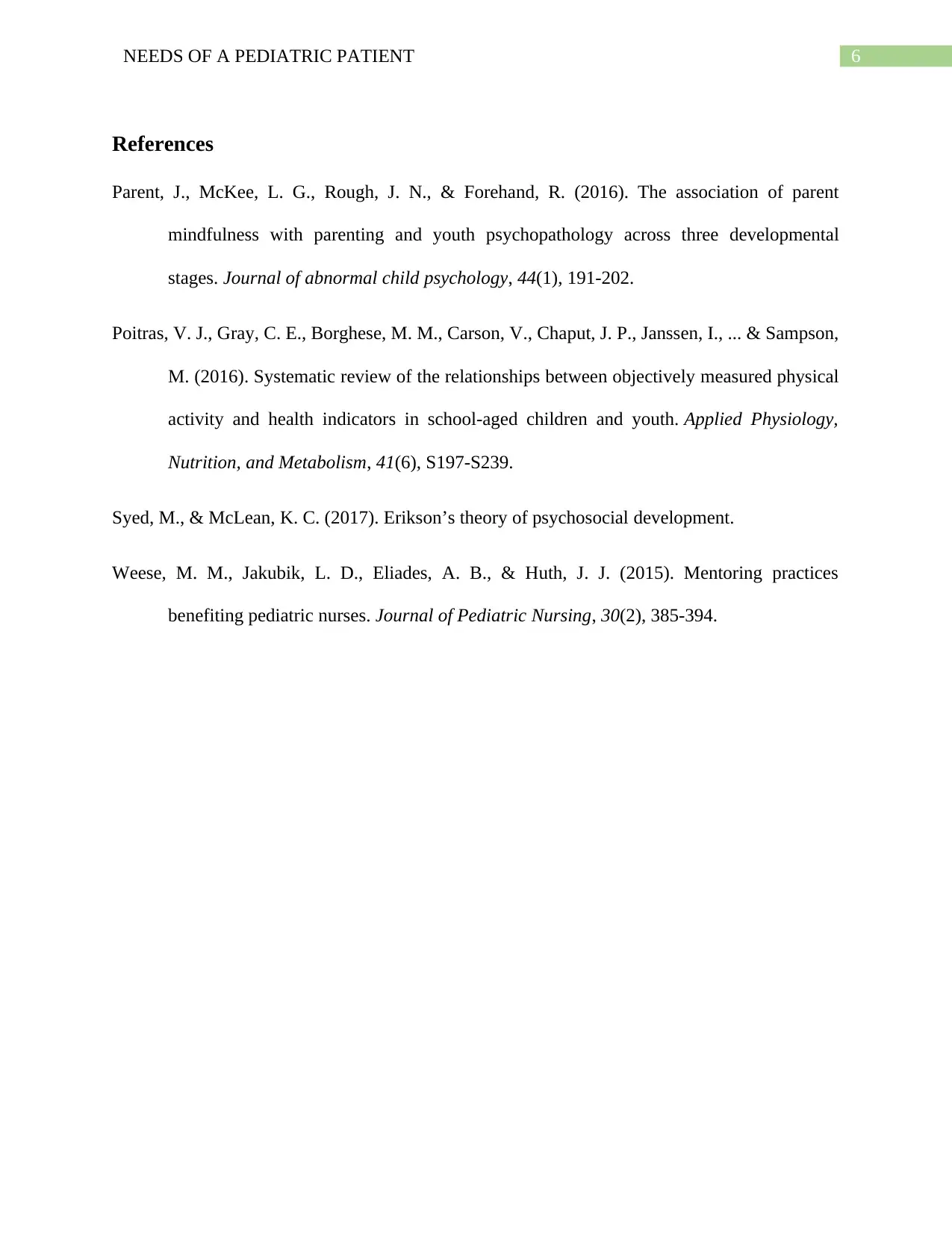
6NEEDS OF A PEDIATRIC PATIENT
References
Parent, J., McKee, L. G., Rough, J. N., & Forehand, R. (2016). The association of parent
mindfulness with parenting and youth psychopathology across three developmental
stages. Journal of abnormal child psychology, 44(1), 191-202.
Poitras, V. J., Gray, C. E., Borghese, M. M., Carson, V., Chaput, J. P., Janssen, I., ... & Sampson,
M. (2016). Systematic review of the relationships between objectively measured physical
activity and health indicators in school-aged children and youth. Applied Physiology,
Nutrition, and Metabolism, 41(6), S197-S239.
Syed, M., & McLean, K. C. (2017). Erikson’s theory of psychosocial development.
Weese, M. M., Jakubik, L. D., Eliades, A. B., & Huth, J. J. (2015). Mentoring practices
benefiting pediatric nurses. Journal of Pediatric Nursing, 30(2), 385-394.
References
Parent, J., McKee, L. G., Rough, J. N., & Forehand, R. (2016). The association of parent
mindfulness with parenting and youth psychopathology across three developmental
stages. Journal of abnormal child psychology, 44(1), 191-202.
Poitras, V. J., Gray, C. E., Borghese, M. M., Carson, V., Chaput, J. P., Janssen, I., ... & Sampson,
M. (2016). Systematic review of the relationships between objectively measured physical
activity and health indicators in school-aged children and youth. Applied Physiology,
Nutrition, and Metabolism, 41(6), S197-S239.
Syed, M., & McLean, K. C. (2017). Erikson’s theory of psychosocial development.
Weese, M. M., Jakubik, L. D., Eliades, A. B., & Huth, J. J. (2015). Mentoring practices
benefiting pediatric nurses. Journal of Pediatric Nursing, 30(2), 385-394.
1 out of 7
Related Documents
Your All-in-One AI-Powered Toolkit for Academic Success.
+13062052269
info@desklib.com
Available 24*7 on WhatsApp / Email
![[object Object]](/_next/static/media/star-bottom.7253800d.svg)
Unlock your academic potential
Copyright © 2020–2025 A2Z Services. All Rights Reserved. Developed and managed by ZUCOL.





